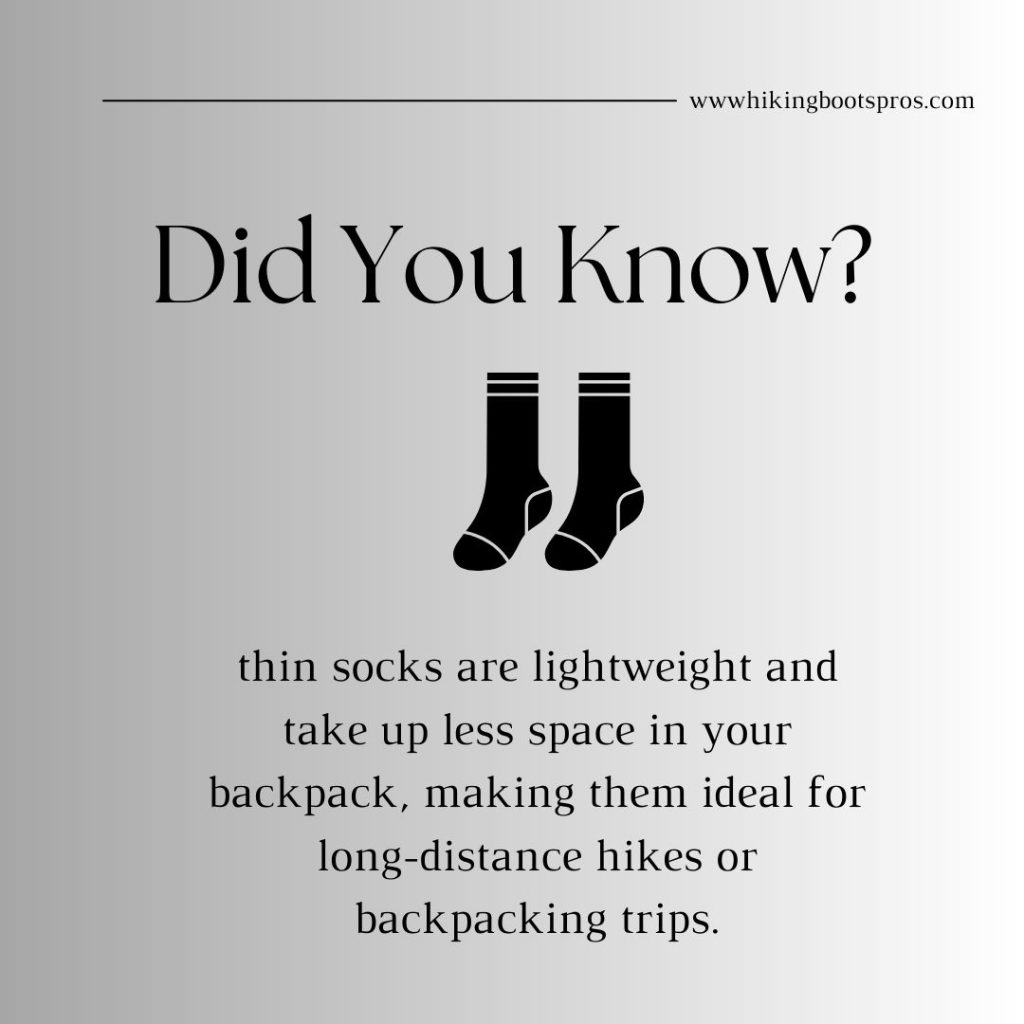When it comes to hiking, the right gear can make or break your experience. One of the most important items to consider is the type of socks you wear. But with so many options available, it can be overwhelming to choose the right pair.
Should you opt for thin socks or thick socks? In this article, we will explore the benefits of each type of sock and discuss the factors to consider when choosing the right socks for your hiking adventures.
What Are the Benefits of Thin Socks for Hiking?

Thin socks have several benefits that make them a popular choice for hikers. Firstly, they provide a snug and secure fit, which is important for preventing blisters and hot spots.
The thin material also allows your feet to breathe and stay cool, reducing the likelihood of sweaty feet and foot odor. Additionally, thin socks are lightweight and take up less space in your backpack, making them ideal for long-distance hikes or backpacking trips.
Snug and Secure Fit
A snug and secure fit is essential for preventing blisters and hot spots. Thin socks provide a closer fit to your foot, reducing the amount of friction between your skin and the sock. This, in turn, reduces the risk of blisters and hot spots forming during your hike.
Breathability
One of the biggest advantages of thin socks is their breathability. The thin material allows your feet to breathe, which reduces the amount of sweat that accumulates inside your shoes. This can help prevent foot odor and reduce the likelihood of blisters caused by damp or sweaty feet.
Lightweight
Thin socks are lightweight and take up less space in your backpack. This makes them an ideal choice for hikers embarking on long-distance hikes or backpacking trips where weight and space are important considerations.
Perks of Wearing Thin Socks
While thin socks are a popular choice for hikers, thick socks also have their benefits. Firstly, they provide more cushioning and support, which can be important for hikers carrying heavy backpacks or trekking over uneven terrain. Thick socks also provide more insulation, making them a good choice for hiking in colder climates.
Cushioning and Support
Thick socks provide more cushioning and support than thin socks, which can be important for hikers carrying heavy backpacks or trekking over rough terrain. The extra padding can help reduce fatigue and foot soreness, allowing you to hike for longer periods.
Insulation
Thick socks provide more insulation, making them an excellent choice for hiking in colder climates. The extra layers help trap warmth close to your skin, keeping your feet warm and comfortable even in sub-zero temperatures.
Durability
Thick socks are often more durable than thin socks. The extra material means they are less likely to wear out or develop holes, making them a good choice for hikers who are looking for a long-lasting sock option.
What are the factors to consider when choosing socks for Hiking?
Choosing the right socks for hiking is important to ensure your comfort and safety on the trail. Here are some factors to consider when selecting the perfect pair of hiking socks.
Material
The material of the sock is an important factor to consider when choosing hiking socks. Materials like merino wool and synthetic blends are popular choices because they wick away moisture and dry quickly, helping to keep your feet dry and comfortable.
Merino wool is a popular material for hiking socks as it is moisture-wicking, breathable, and naturally antimicrobial. Synthetic materials like nylon and polyester are also commonly used as they are durable and quick-drying.
Fit
The fit of the sock is also important. A sock that is too loose can bunch up and cause blisters, while a sock that is another factor to consider is the climate and weather conditions.
If you are hiking in colder temperatures or the snow, thick socks will provide more insulation and keep your feet warmer. On the other hand, if you are hiking in warmer temperatures, thin socks will allow your feet to breathe and prevent sweating and discomfort.
It is also important to consider the fit of your socks. Socks that are too tight can restrict blood flow and cause discomfort, while socks that are too loose can cause friction and blisters. Make sure to choose socks that fit well and provide support without being too tight.
Overall, the decision to wear thick or thin socks for hiking depends on personal preference and specific hiking conditions. Consider the abovementioned factors and choose socks that are comfortable, fit well, and provide the necessary support and insulation for your hike.
What are the factors to consider when choosing socks for Hiking?
When it comes to choosing socks for hiking, there are several factors to consider. Let’s take a look at some of the most important ones:
Material
As mentioned earlier, the material of the socks is important as it affects the breathability, moisture-wicking, and antimicrobial properties of the socks. Merino wool, synthetic materials like nylon and polyester, and blends of different materials are all options to consider.
Thickness
The thickness of the socks should be chosen based on the hiking conditions and personal preference. Thick socks provide more insulation and warmth, while thin socks allow for better breathability and ventilation.
Fit
The fit of the socks is crucial in preventing blisters and discomfort. Socks that are too tight can restrict blood flow and cause discomfort, while socks that are too loose can cause friction and blisters.
Cushioning
Some socks come with extra cushioning in certain areas, such as the heel and toe, to provide additional support and prevent blisters.
Height
Socks come in different heights, including ankle-length, crew-length, and knee-high. The height of the socks should be chosen based on personal preference and hiking conditions.
By considering these factors and choosing socks that are comfortable, fit well, and provide the necessary support and insulation, you can ensure a comfortable and enjoyable hiking experience.
HAVE A LOOK AT: Can hiking boots be used for winter
Conclusion
In conclusion, the decision to wear thick or thin socks for hiking depends on personal preference and specific hiking conditions.
Both thick and thin socks have their advantages and disadvantages, and it’s important to choose socks that are comfortable, fit well, and provide the necessary support and insulation for your hike.
When choosing socks for hiking, consider factors such as material, thickness, fit, cushioning, and height. By taking these factors into account, you can ensure a comfortable and enjoyable hiking experience.
FAQs
Wear socks that fit well, are made from moisture-wicking and quick-drying materials like synthetic materials or wool, and consider the hiking conditions. Avoid wearing cotton socks.
It depends on personal preference and the conditions of your hike. Thin socks are suitable for hot weather and lightweight hiking, while thick socks offer extra padding and insulation for cold-weather hikes or hikes with heavy backpacks.
Thick socks can help prevent blisters by reducing the friction between your feet and hiking boots, but it’s essential to choose socks that fit well and are made from appropriate materials.

Tyler Looney is an avid hiking enthusiast and the author of HikingBootsPros.com, a website dedicated to providing helpful insights and advice on choosing the best hiking boots. His expertise and passion for hiking have made him a valuable resource for both beginner and experienced hikers alike.

